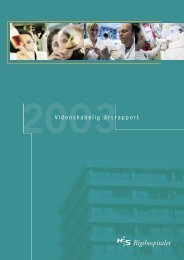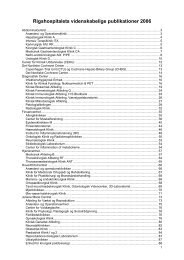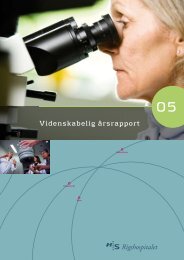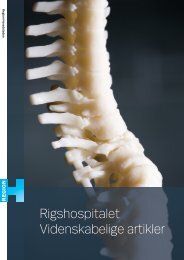View - CTU
View - CTU
View - CTU
Create successful ePaper yourself
Turn your PDF publications into a flip-book with our unique Google optimized e-Paper software.
Bj¢rndal & Reit Adoption of new technology<br />
Adoption of r<br />
motivated and encouraged to use rubber dam in order<br />
to produce high quality treatment (Bjorndal 2002).<br />
The adoption of new endodontic instrumentation<br />
and filling techniques seemed to be associated neither<br />
with gender (only electronic measuring devices were<br />
more used by males) nor age (year of graduation) of the<br />
dentists. The latter might be explained by the very<br />
recent inclusion ofNiTi technology in the curriculum of<br />
the Danish dental schools (Bjorndal et al. 2001).<br />
However, male dentists completed cases in fewer<br />
treatment sessions than female dentists, and young<br />
practitioners spent more appointments on the instrumentation<br />
of a molar than their more senior colleagues.<br />
It has been proposed that the adoption of one<br />
technology may lead to the adoption of others that<br />
are closely related (Rogers 19 8 3, Molander et al.<br />
1996). Such a technology cluster was observed also<br />
in the present study. Several significant associations/<br />
correlations were found between the technologies,<br />
indicating that the front-runners and early adopters<br />
did not view the innovations in isolation. The adoption<br />
of NiTi technology seemed to influence the time spent<br />
per case. Use of rotary systems was significantly<br />
associated with less instrumentation sessions as well<br />
as fewer numbers of visits needed to complete a case.<br />
This was also noted in the Australian survey (Parashos<br />
& Messer 2004) where 80% of the users of rotary<br />
instrumentation reported a more rapid preparation of<br />
root canals.<br />
Conclusions<br />
According to Rogers' (1983) diffusion curve (Fig. 1)<br />
the adoption of new endodontic technology amongst<br />
Danish GPs is in an early phase. The adoption<br />
frequencies of the innovations varied between 10 and<br />
30%, a position where a more rapid diffusion rate<br />
might be expected in the near future. A new Danish<br />
remuneration system might influence the rate of<br />
adoption but progress towards high quality endodontics<br />
might be hindered by the nonuse of rubber dam.<br />
Acknowledgements<br />
The Copenhagen Dental Society is gratefully acknowledged<br />
for their contribution towards the present<br />
study. Professor Niels Keiding, Department of Biostatistics,<br />
University of Copenhagen is kindly acknowledged<br />
for his critical review of the paper. Lisbeth<br />
Carstensen is acknowledged for running the Digram<br />
analyses.<br />
References<br />
Bishop K, Dummer PMH (1997) A comparison of stainless<br />
steel Flexofiles and nickel-titanium Ni-Tiflex files during the<br />
shaping of simulated canals. International Bndodontic Journal<br />
30, 25-34.<br />
Bjmndal L (2002) Anvendelse af kofferdam i den endodontiske<br />
procedure hos voksne. Tandlaegebladet 106, 784-92.<br />
Bjorndal L, Reit C (2004) The annual frequency of root fillings,<br />
tooth extractions, and pulp related procedures in Danish<br />
adults 1977-2003. International Bndodontic Journal 37,<br />
782-8.<br />
Bjorndal L, Langemark C, Onuoha M (2001) Dental student<br />
procedures of pulpectomy and root canal treatment at the<br />
university of Copenhagen (Abstract). The 10th Biennial<br />
Congress ESE, Munich, Germany (No. 1).<br />
Brorson B, Wall S (1985) Assessment of Medical Technology -<br />
Problems and Methods. Stockholm: Swedish Medical<br />
Research Council.<br />
Dugas NN, Lawrence HP, Teplitsky PE, Pharoah MJ, Friedman<br />
S (2003) Periapical health and treatment quality assessment<br />
of root-filled teeth in two Canadian populations.<br />
Intemational Bndodontic Journal 36, 181-92.<br />
Dummer PM, Lyle L, Rawle J, Kennedy JK (1994) A laboratory<br />
study of root fillings in teeth obturated by lateral condensation<br />
of gutta-percha or Thermafil obturators. Intemational<br />
Endodontic Journal 27, 32-8.<br />
Eriksen HM, !Grkevang L-L, Petersson K (2002) Endodontic<br />
epidemiology and treatruent outcome: general considerations.<br />
Bndodontic Topics 2, 1-9.<br />
Gulabivala K, Holt R, Long B (1998) An in 1•itro comparison of<br />
thermoplasticized gutta-percha obturation techniques with<br />
cold lateral condensation. Bndodontics and Dental Traumatology<br />
14, 262-9.<br />
Hoer D, Attin T (2004) The accuracy of electronic working<br />
length determination. International Bndodontic Journal 3 7,<br />
125-31.<br />
Hommez GMG, Braem M, DeMoor RJG (2003) Root canal<br />
treatment performed by Flemish dentist. Part 1. Cleaning<br />
and shaping. International Bndodontic Journal 36, 166-<br />
73.<br />
Jenldns SM, Hayes SJ, Dummer PMH (2001) A study of<br />
endodontic treatment carried out in dental practice within<br />
the UK. International Endodontic Journal 34, 16-22.<br />
Kirkevang L-L, Hiirsted-Bindslev P, 0rstavik D, Wenzel A<br />
(2000) Periapical status and quality of root fillings and<br />
coronal restorations in a Danish population. International<br />
Bndodontic Journal 33, 509-15.<br />
Kvist T, Molander A, Dahlen G, Reit C (2004) Microbiological<br />
evaluation of one- and two-visit' endodontic treatment of<br />
teeth with apical periodontitis. A randomised clinical trial.<br />
Journal of Bndodontics 30, 5 72-6.<br />
McColl E, Smith M, Whitworth J, Seccombe G, Steele j (1999)<br />
Barriers to improving endodontic care: the views of NHS<br />
practitioners. British Dental Journal 186, 564--8.<br />
Molander A<br />
acceptanc<br />
sampling.<br />
Molander ,<br />
Improved<br />
tioners u~<br />
of Dental<br />
Parashos P<br />
use of n<br />
dentists.<br />
Park H (2C<br />
and stair<br />
Surgery,<br />
Peters LB,<br />
donticall.<br />
the pres<br />
Internatil<br />
Pratten DE<br />
and elec<br />
173-6.<br />
© 2005 International Endodontic Journal<br />
International Endodontic Journal, 38, 52-58, 2005<br />
•<br />
lnternatior








